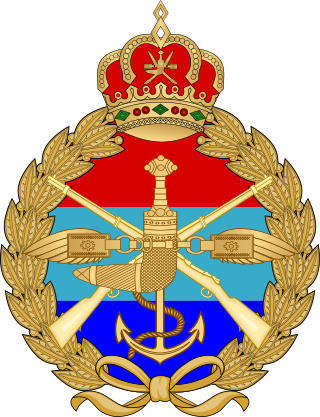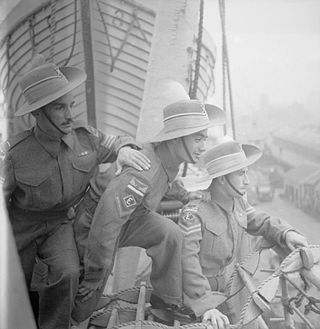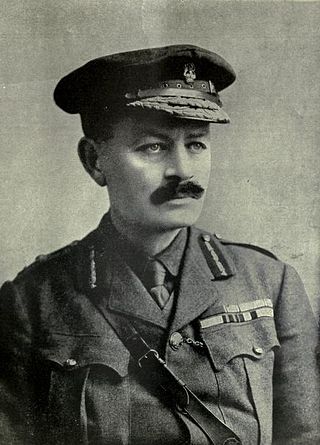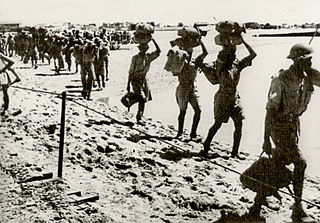
The Yemeni Armed Forces are the military forces of the Republic of Yemen. They include the Yemeni Army, Yemeni Navy and the Yemeni Air Force. Since the start of the current civil war in 2014, the armed forces have been divided; at first between loyalists of the former president Ali Abdullah Saleh and pro-Yemeni government forces of president Abdrabbuh Mansour Hadi; as of 2024, between the internationally recognized Presidential Leadership Council (PLC), and the Houthi-led Supreme Political Council (SPC). Per the constitution, the President of Yemen serves as the commander-in-chief. Currently, the presidency and supreme command of the armed forces is disputed between Rashad al-Alimi, Chairman of the PLC, and Mahdi al-Mashat, chairman of the SPC. Before the civil war, the united military was headquartered in the country's capital, Sana’a.

Number 8 Squadron of the Royal Air Force last operated the Boeing E-3D Sentry AEW1 (AWACS) from RAF Waddington, Lincolnshire. As of 2020, the RAF AWACS fleet was made up of three Sentry AEW1s, down from seven originally ordered in the late 1980s. Pursuant to the 2021 defence review, the E-3D Sentry aircraft made its final flight in U.K. service in August 2021.

The Royal Air Force Regiment is part of the Royal Air Force and functions as a specialist corps. Founded by Royal Warrant in 1942, the Corps carries out basic security tasks relating to the [protection of] delivery of air power. Examples of such tasks are non-combatant evacuation operation (NEO), recovery of downed aircrew, defence of airfields by way of aggressively patrolling and actively seeking out infiltrators in a large area surrounding airfields. The key tenet of the RAF Regiments role is based around defensive security operations, rather than the Army’s more traditional offensive infantry role, which is to close with and kill the enemy; notwithstanding, this does require active patrolling just outside the Airfield perimeter. In addition the RAF Regiment provides Joint Terminal Attack Controllers (JTACs) to the British Army in the Tactical Air Control Party (TACP) role, and provides a very small commitment to the Special Forces Support Group as Tactical air controllers and some CBRN specialists.

Number 43 Squadron, nicknamed the Fighting Cocks, was a Royal Air Force aircraft squadron originally formed in April 1916 as part of the Royal Flying Corps. It saw distinguished service during two world wars, producing numerous "aces". The squadron last operated the Panavia Tornado F3 from RAF Leuchars, Scotland, in the air defence role, until it was disbanded in July 2009.

The Sultan of Oman's Armed Forces are the Royal Army of Oman, Royal Navy of Oman, Royal Air Force of Oman, Sultan's Special Force and other defense forces of the Sultanate of Oman. Since their formal establishment in the early 1950s, with British assistance SAF has twice overcome insurgencies which have threatened the integrity or social structure of the state, and more recently have contributed contingents or facilities to coalitions formed to protect Arab states of the Persian Gulf.

The Aden Protectorate was a British protectorate in southern Arabia. The protectorate evolved in the hinterland of the port of Aden and in the Hadhramaut after the conquest of Aden by the Bombay Presidency of British India in January 1839, and which continued until the 1960s. In 1940, it was divided for administrative purposes into the Western Protectorate and the Eastern Protectorate. The territory now forms part of the Republic of Yemen.

Beihan or Bayhan, officially the Emirate of Beihan, was a state in the British Aden Protectorate and the Federation of South Arabia. Its capital was Suq Abdulla, now called Beihan. The Emirate was abolished in 1967 upon the founding of the People's Republic of South Yemen and is now part of the Republic of Yemen.

The Aden Emergency, also known as the 14 October Revolution or as the Radfan Uprising, was an armed rebellion by the National Liberation Front (NLF) and the Front for the Liberation of Occupied South Yemen (FLOSY) against the Federation of South Arabia, a British Protectorate of the United Kingdom, which led to the proclamation of the People's Republic of South Yemen.

The Iraq Levies were the first Iraqi military force established by the British in British controlled Iraq. The Iraq Levies originated in a local armed scout force raised during the First World War. After Iraq became a British Mandate, the force was composed mostly of Assyrians, Kurds and Iraqi Turkmen who lived in the north of the country, while the nascent Iraqi Army was recruited first from the Arabs who had joined the Iraqi Levies and later from the general Arab population (Beth-Kamala). Eventually the Levies enlisted mainly Assyrian soldiers with British officers. The unit initially defended the northern frontiers of the Province of Mosul when Turkey claimed the province and massed its army across the frontiers. After 1928 the prime role of the Levies was to guard the Royal Air Force bases located in Iraq.

The Somaliland Camel Corps (SCC) was a British Colonial Auxiliary Forces unit which was raised in British Somaliland. It existed from 1914 until 1944.

Royal Air Force Khormaksar or more simply RAF Khormaksar is a former Royal Air Force station in Aden, Yemen. Its motto was "Into the Remote Places". During the 1960s, it was the base for nine squadrons and became the RAF's busiest-ever station as well as the biggest staging post for the RAF between the United Kingdom and Singapore.
The Trucial Oman Scouts was a paramilitary force that the British raised in 1951 as the Trucial Oman Levies, to serve in the Trucial States. In 1956, the Levies were renamed the Trucial Oman Scouts. In 1971, upon the formation of the United Arab Emirates (UAE), the scouts were handed to the United Arab Emirate's government and formed its Federal Union Defence Force (UDF) which is today renamed as the United Arab Emirates Armed Forces.
British Forces Aden was the name given to the British Armed Forces stationed in the Aden Protectorate during part of the 20th century. Their purpose was to preserve the security of the Protectorate from both internal threats and external aggression.
No. 94 Squadron RAF was a unit of the Royal Air Force that served during World War I and World War II. The squadron has been formed a total of four times.
Robert Alexander Benjamin Hamilton, 12th Lord Belhaven and Stenton, was a Scottish soldier, colonial administrator, author, and peer. He was a Fellow of both the Royal Geographical Society and the Royal Australasian College of Surgeons.

On 15 August 1944, Allied forces carried out Operation Dragoon, a set of simultaneous amphibious landings by three US infantry divisions followed by four Free French divisions along the Mediterranean coast of France. The main landings were preceded by nighttime paratroop drops and commando beach landings. This was a phase of the European Theatre of World War II.

The campaign in South Arabia during World War I was a minor struggle for control of the port city of Aden, an important way station for ships on their way from Asia to the Suez Canal. The British Empire declared war on the Ottoman Empire on 5 November 1914, and the Ottomans responded with their own declaration on 11 November. From the beginning, the Ottomans had planned an invasion of Britain's Aden Protectorate in cooperation with the local Arab tribes. The Ottomans had gathered in some strength on the Cheikh Saïd, a peninsula which juts out into the Red Sea towards the island of Perim.

The Aden riots of December 2–4, 1947 targeted the Jewish community in the British Colony of Aden. The riots broke out from a planned three-day Arab general strike in protest of United Nations General Assembly Resolution 181 (II), which created a partition plan for Palestine. The riots resulted in the deaths of 82 Jews, 33 Arabs, 4 Muslim Indians, and one Somali, as well as wide-scale devastation of the local Jewish community of Aden. The Aden Protectorate Levies, a military force of local Arab-Muslim recruits dispatched by the British governor Reginald Champion to quell the riots, were responsible for much of the killing.

The Force in Egypt was a British Army formation established in August 1914 to administer garrisoning armed forces in Egypt at the beginning of the First World War. The force had the objective of protecting the Suez Canal and was originally commanded by Major General Julian Byng, but he was replaced by General J. Maxwell, who took command on 8 September 1914. Initially, the main threat to the Suez came from Germany and throughout the early months several of the force's elements were sent to Europe to take part in the fighting on the Western Front. On 5 November 1914, Britain and France declared war on the Ottoman Empire, after which the Force in Egypt faced a direct threat from Ottoman forces, which was realised in February 1915 with a raid on the Suez Canal. This threat remained until 1916 when the British forces went on the offensive.

Operation Appearance was a British landing in the British Somaliland Protectorate against troops of the Italian Army. The Italian conquest of British Somaliland had taken place seven months previously, in August 1940. The British had withdrawn from the protectorate after a delaying action at the Battle of Tug Argan. This withdrawal, after the disastrous conclusion of the Battle of France and the Italian declaration of war on 10 June 1940, had repercussions among British leaders. It led Prime Minister Winston Churchill to lose confidence in General Archibald Wavell, the British commander in the Middle East, which culminated in Wavell's sacking on 20 June 1941.

















